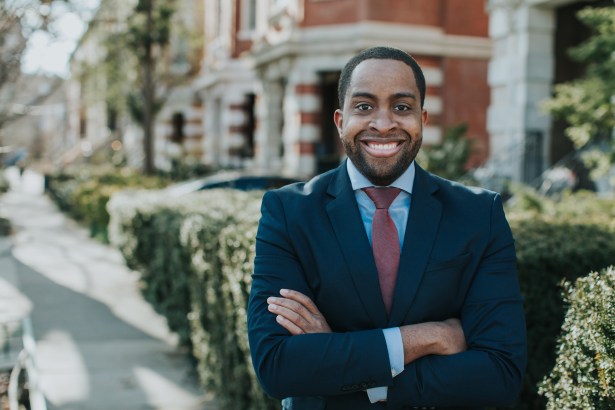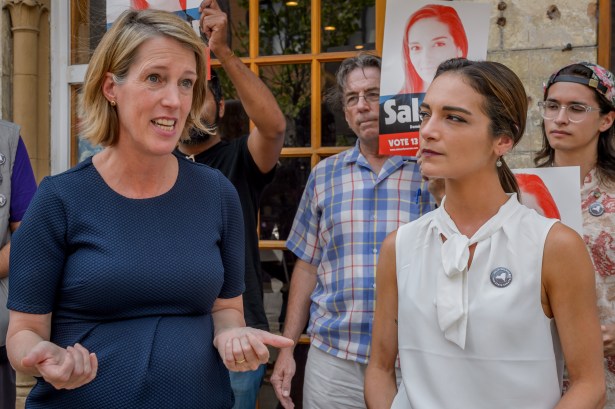A Rent Regulation Fight Is Brewing in Albany
By Rebecca Baird-Remba January 15, 2019 12:00 pm
reprints
After the people of New York swept a blue wave of progressive Democrats into the state senate during the 2018 midterm elections, every newly-elected senator from New York City seemed to be talking about tenants’ rights and reforming the state’s outdated rent-stabilization system.
The energized freshman senate crew, which includes Zellnor Myrie, Alessandra Biaggi and Julia Salazar, is determined to strengthen New York’s 70-year-old rent laws. On Jan. 9, the Democrats took control of the senate for the first time since 2009, when they only held on to a slim majority for a year. Before that, the Demoracts spent 43 years in the minority.
“The real estate industry has been living large because of gaping loopholes they’ve opened up in the rent-regulation system,” said Michael Gianaris, a state senator from western Queens who chairs the chamber’s Democratic conference. “And now there’s a majority in the senate that wants to change that for the first time in 20 or 30 years.”
It’s certainly not the first time New York City legislators have pushed for eliminating measures that make it easier for landlords to raise rents on tenants. Longtime senators and assembly members from the five boroughs have tried for decades to introduce bills that would overturn landlord-friendly portions of the rent-regulation laws. Usually, those efforts—like many progressive proposals—passed the assembly and died in the senate. But this time is different, according to politicians, activists and policy experts. Change may finally be on the horizon for residents of the city’s 1 million rent-regulated apartments.
Myrie and Salazar both campaigned on a particularly aggressive housing platform called “universal rent control.” The term refers to a package of bills that would expand rent stabilization throughout the entire state, make it easier for tenants to sue landlords for unsafe living conditions, change policies that allow owners to significantly raise rents on stabilized tenants, and give renters across the state stronger protection against evictions.
“The voters responded pretty forcefully to a message about expanding our affordable housing and protections so I think we should fight for that,” Myrie said. “I think we’re at crisis levels and we need a crisis response.”

Biaggi advocated for a more measured platform that included eliminating increases on preferential rents, better transparency for rent increases related to renovations, and eliminating the vacancy bonus, a tool that landlords use to raise rents 20 percent when rent-regulated tenants leave. Senior Democratic senators and housing groups from New York City seem to be advancing a legislative reform that falls somewhere in between these two positions.
Even Gov. Andrew Cuomo came out last month in support of repealing vacancy decontrol, which allows landlords to deregulate apartments when renters move out under certain circumstances. Combined with rent increases triggered by renovations, landlords can push an empty apartment’s rent to the deregulation threshold, currently at $2,774, and remove it from rent stabilization entirely.
Of course, it’s not the first time Cuomo has embraced this policy plank. He supported ending vacancy decontrol in a 2015 New York Daily News op-ed while touting his bona fides as a former secretary for the federal Department of Housing and Urban Development. When the state senate failed, in June 2015, to pass a version of the rent regulations that rolled back vacancy deregulation, Cuomo blamed it on the senate’s Republican majority. Activists weren’t buying it.
“I think he’s schooling us,” Tenants Political Action Committee treasurer Michael McKee told Politico’s Jimmy Vielkind at the time. “I think he really, fundamentally sides with the landlords.”
Advocacy groups have long questioned Cuomo’s commitment to pro-tenant laws, pointing to the fact that he continues to raise more money from real estate interests than any other politician in the state. Brookfield Properties, Durst Organization, SL Green Realty Corp. and RXR Realty CEO Scott Rechler have all topped the list of the governor’s biggest campaign donors over the past four years, collectively pumping millions into his war chest, Politico reported last July. The Dursts, the LeFraks, Brookfield and Extell Development Company chief Gary Barnett together gave hundreds of thousands to Cuomo’s campaign in 2018 alone, campaign finance records show.
Now that rent laws are up for renewal once again in June, tenant and housing groups are calling the governor’s bluff and demanding he help push through tenant-friendly legislation.
“Ending vacancy decontrol has been an agenda item of housing advocates for a long time,” said State Senator Liz Krueger, who represents Manhattan’s East Side. “The fact that you have the governor, the senate and the assembly saying they want to get it done means it’s going to get done.”
A group of housing advocacy organizations that includes the Legal Aid Society, Enterprise Community Partners, the New York State Association for Affordable Housing (NYSAFAH) and the Association for Neighborhood Housing and Development, will push for a three-pronged platform of rent reforms when the legislature returns from break this month. Their demands include ending vacancy decontrol, restoring preferential rent protections and reforming the 20 percent “vacancy bonus,” major capital improvements (MCIs) and individual apartment improvements (IAIs). MCIs allow landlords to raise rents because of renovations that benefit the entire building, such as boiler upgrades or new roofs. IAIs permit increases for fixing up individual apartments with new appliances or repainting walls.
However, the state housing agency rarely checks to see if landlords have completed the apartment upgrades that they report in order to justify rent increases, a recent investigation by The Real Deal found.

“The system of IAIs is designed not to have oversight, so there is rampant fraud,” said Judith Goldiner, the attorney in charge of the civil law reform unit at the Legal Aid Society.
The Real Estate Board of New York, for its part, seems to have accepted that reforms are coming regardless of what they do. Still, the real estate lobby isn’t going down without a fight.
“If you eliminate major capital improvements, then you make it almost impossible for an owner to invest in the capital assets with new windows, roof systems and other major components,” said REBNY President John Banks. “MCIs have created incentives for people to invest in their assets. If you eliminate MCIs, owners will make rational economic choices.”
Repealing vacancy decontrol “could be a hit on the city’s tax revenue basis,” because as landlords remove apartments from rent regulation, owners pay higher taxes to the city. If apartments won’t exit the rent-regulation system anymore, Banks argued that decreased property tax revenue “could put pressure on the city to cut services down the road.” If vacancy decontrol must go, “we would want to have a conversation about what can be done to offset the lost revenue from that situation, whether it’s a tax abatement or something else that will help owners make a reasonable return on their investment and provide a cross subsidy to units that remain within the regulatory framework.”
Even advocates aren’t united on how they should reform MCIs and IAIs. Some politicians and activists believe the two systems are irredeemably broken and should be completely eliminated from state law. Gianaris is leading the charge with a bill to axe MCIs. His current proposal calls for landlords to receive tax credits for making upgrades, but he said that could change.
“There’s not going to be a lot of sympathetic ears for the notion that landlords cannot handle this when tenants have been driven out of their homes for MCI abuses for so long,” Gianaris said. “Every day there are submissions for MCIs for work that isn’t necessary.”
Krueger disagrees with Gianaris’ approach. The 17-year senate veteran believes landlords should be allowed to increase rents long enough for them to recoup the cost of apartment or building improvements, which usually takes several years, she said. This would be a change from the current system, which passes a percentage of renovation costs onto a tenant in the form of permanent rent increases.
“With MCIs, right now the landlord sets a number and spends the money, but we don’t make him prove it,” the Upper East Side legislator explained. “He claims, ‘This is what I’m going to spend the money on, and this is legitimate.’ In my world, you’d be allowed to get reimbursed for that cost over a six- or seven-year timeline divided by the number of units.”
She added, “It’s the gift that keeps on giving if you want to play it corruptly. If you want to play it straight, [rent increases equal] the amount you paid out in MCIs forever.”
Housing policy groups in the rent-reform coalition are divided along similar lines. “We are not unified on how MCIs should be reformed,” said Ellen Davidson, a housing attorney at Legal Aid who argued that landlords don’t need renovation-related rent increases to cover the costs of running properties. “The rent guidelines board increases cover operating costs,” she explained. “Landlords’ profits continue to increase year after year.”
Jolie Milstein, who represents the affordable housing development industry as the head of NYSAFAH, said that her group is “not recommending eliminating MCIs at this time. But what we’ve all agreed to is to continue to provide incentives for landlords to maintain their buildings. We don’t want to place a burden on landlords that makes it impossible for them to maintain their housing stock.”
There’s also the question of folding energy-efficient upgrades for rent-stabilized buildings into this new legal framework. Astoria City Councilman Costa Constantinides has been pushing a bill that would require all buildings over 25,000 square feet to meet certain carbon emissions and retrofitting requirements as part of the city’s effort to slash its greenhouse gas emissions 80 percent by 2050. The current draft of the bill exempts rent-stabilized buildings from the new rules because activists and lawmakers alike worried the improvements would trigger rent increases. The councilman has argued for months that buildings with stabilized units could be added back into the legislation once the legislature reforms or eliminates MCIs in June.
State senators, however, told Commercial Observer that the council hasn’t spoken to them about the issue yet. Gianaris, who represents much of the same northwestern Queens territory as Constantinides, said he hadn’t followed the bill. When asked about the retrofitting proposal, Krueger replied that she “didn’t understand the point of the bill” if it carved out properties with rent-stabilized units, because it wouldn’t apply to more than half of New York City’s housing stock.
Senator Brian Kavanaugh, who was just chosen as the chair of the senate housing committee, said he hadn’t reviewed the legislation. But he explained that encouraging energy-efficient upgrades was still a priority. “We do want to provide incentives for both commercial and residential landlords to improve the energy efficiency of their building, and it is a legitimate question about how it intersects with the MCI system,” he noted. “You could change the law so that if you’re getting the state energy-efficiency subsidies, you couldn’t take an MCI. If the state legislature wants to address the issue, there are certainly ways to address it.”
The legislature will also have to grapple with funding increased enforcement of the rent laws. Stricter rent laws will only be effective if the state can afford to add more staff to the Department of Housing and Community Renewal (DHCR), which is charged with enforcing rent-stabilization laws in New York City and the surrounding counties.
Krueger wants to pay for new enforcement staff by increasing a $10 fee that landlords pay annually to the state for each apartment they register as rent-regulated. Upping the fee to $30 could generate an additional $19.8 million, assuming that the landlords of all of New York City’s 988,193 rent-stabilized and rent-controlled apartments paid the registration fee to the city’s Department of Finance, which then turns the cash over to the state government.
The Manhattan senator has a lengthy wish list of reforms for other kinds of rent-regulated housing, too. The city’s 22,000 rent-controlled apartments house many of its oldest and poorest tenants, but state law typically allows annual rent hikes of up to 7.5 percent for rent-controlled units. Instead she wants to bring those units under the jurisdiction of the Rent Guidelines Board, which typically sets much smaller increases of 1 to 2 percent for stabilized units. She also wants to extend funding for the state Mitchell-Lama program or ensure that units constructed under the 1950s city-sponsored housing program will enter the rent-stabilization system.
Unsurprisingly, owners of rent-stabilized buildings are raising the alarm about reforms.
“Progressive legislators out there are interested in really making a big political statement, but at the end of the day, are they going to do more harm than good?” asked Robert Nelson, whose real estate firm Nelson Management owns 3,200 apartments throughout the five boroughs. Rolling back vacancy decontrol and MCIs could return New York City to a 1980s-level of decay, he argued, where building owners don’t have incentives to maintain their properties.
“The question becomes, what happens when you reverse the law on a lot of these items that are being bandied about by state legislators?” Nelson said. “Do you create a situation where rent-stabilized housing become like NYCHA housing? That’s not an accident; this is the result of years of disinvestment.”
Nelson also contended that less rental revenue will mean fewer building staff and fewer repairs.
“A lot of us in the industry feel that you will affect a lot of the workers who work in these buildings, the contractors that work in these buildings. Some of these people may be put out of work as a result. How does that affect the New York City economy?”


